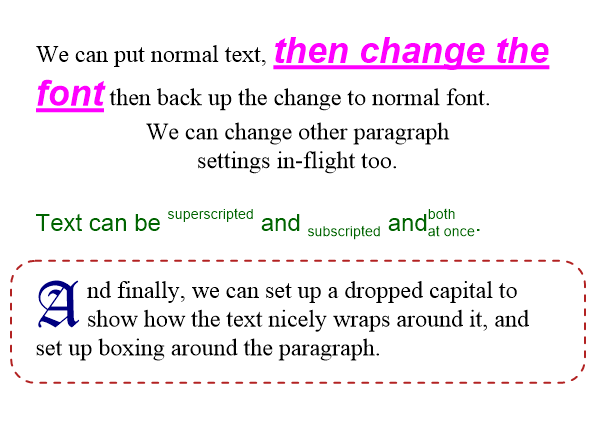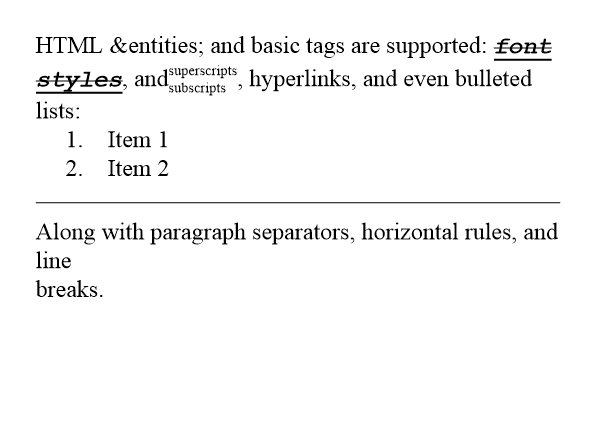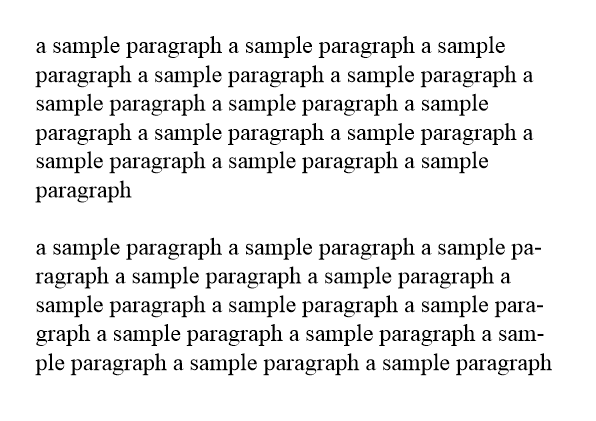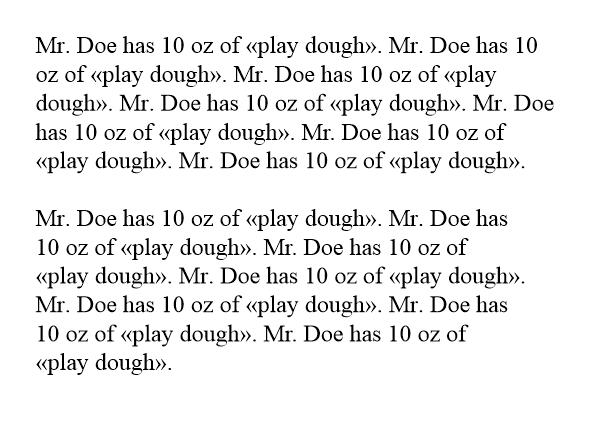| Automated charting and reporting |
SharpPlot Tutorials
General Tutorials
Chart Samples
Style Examples
Document Layout Tutorials
Table Tutorials
Visual Glossaries
SharpPlot Reference
SharpPlot Class
SharpPlot Properties
SharpPlot Methods
SharpPlot Structures
SharpPlot Enumerations
PageMap Class
SharpLeaf Reference
SharpLeaf Class
SharpLeaf Properties
SharpLeaf Methods
Table Class
Table Properties
Table Methods
SharpLeaf Structures
FontType Structure
ParagraphStyle Structure
BoxStyle Structure
SharpLeaf Enumerations
DocumentLayout Classes
DocumentLayout Class
PageLayout Class
PageElement Abstract Class
Frame : PageElement Class
TextBlock : PageElement Class
ImageBlock : PageElement Class
Box : PageElement Class
Rule : PageElement Class
Common Reference
Document Class
VectorMath Class
DbUtil Class
Download
Release Notes
Licensing
SharpLeaf Tutorials > Text Flow Tutorials > Advanced Text Control
Advanced Text Control
SharpLeaf allows fine character-level control of the output, at the cost of a slightly more complex API than simply SharpLeaf.AddParagraphs.
Character-level control
Text and Paragraphs settings can be changed in-flight in several ways:
- Changing the SharpLeaf.Style property between calls to Add methods
- Changing settings of the ParagraphStyle instance that was passed to SharpLeaf.Style
- Calling the Sharpleaf.PushStyle/SharpLeaf.PopStyle methods
Style modifications can also be passed as string specifications that match the result produced by ParagraphStyle.ToString method (see ParagraphStyle constructor, ParagraphStyle.Set, SharpLeaf.PushStyle, SharpLeaf.AddParagraphs
lf.Style = style = new ParagraphStyle(); // Keep a handle to the current paragraph style style.SpaceBefore = -0.5; style.SpaceAfter = -0.5; // Half a line pitch around each paragraph style.Font = font = new FontType("Times",24); lf.AddText("We can put normal text, "); newfont = new FontType("Arial",36,FontStyle.Italic|FontStyle.Bold| FontStyle.Underline,Color.Fuchsia); style.Font = newfont; // Replace the ParagraphStyle's property lf.AddText("then change the font"); style.Font = font; // Replace again back to previous lf.AddText(" then back up the change to normal font."); lf.NextLine(); // Without the NextLine call, in-flight paragraph style modification would affect the // previous (unfinished) line. lf.PushStyle(newstyle = style.Clone()); // Non-destructive, temporary style modification newstyle.Alignment = Alignment.Center; newstyle.Set("IndentLeft=72 IndentRight=72"); // Specify modification as string lf.AddText("We can change other paragraph settings in-flight too."); lf.PopStyle(); // Back up the temporary style modification lf.NextParagraph(); lf.PushStyle("FontName=\"Arial\" FontColor=DarkGreen"); // Specify modification as string lf.AddText("Text can be "); lf.AddSuperscript("superscripted"); lf.AddText(" and "); lf.AddSubscript("subscripted"); lf.AddText(" and"); lf.AddSuperscript("both"); lf.AddSubscript("at once"); lf.AddText('.'); lf.NextParagraph(); lf.PopStyle(); lf.CapFont = new FontType("Old English Text MT",12,FontStyle.Regular,Color.Navy); lf.SetCap(2); // Set up a dropped capital on two lines box = new BoxStyle(2,Color.Firebrick,LineStyle.Dash,24); lf.PushStyle(); // Temporarily copy current style lf.Style.HorizontalGap = 24; // Use horizontal gutter of 24 points between text and box - Vertical // gutter of the box is provided by the paragraph's SpaceBefore and // SpaceAfter because we start/stop boxing on paragraph boundaries; lf.SetBox(box); // Start boxing lf.AddParagraphs("And finally, we can set up a dropped capital to show how the text "+ "nicely wraps around it, and set up boxing around the paragraph."); lf.SetBox(); // Stop boxing lf.PopStyle();

HTML tags
HTML-formatted text can be input into SharpLeaf through the SharpLeaf.AddHtml method. See that entry for list of supported tags.
lf.AddHtml("<p> HTML &entities; and basic tags are supported: "); lf.AddHtml("<b><i><u><strike><pre>font "+ "styles</pre></strike></u></i></b>, "); lf.AddHtml("and<sup>superscripts</sup><sub>subscripts</sub>, "); lf.AddHtml("<a href=\"www.sharpplot.com\">hyperlinks</a>, "); style.BulletIndent = 72; // HTML bulleted lists uses that - we don't want the default 0 lf.AddHtml("and even bulleted lists: <ol> <li> Item 1 <li> Item 2 "+ "</ol>"); lf.AddHtml("</p> <hr> <p> Along with paragraph separators, "+ "horizontal rules, and line <br> breaks. </p>");

Soft Hyphens
Soft Hyphens can be used when paragraph wrapping is turned on, to specify that hyphenated wrapping is acceptable at those points. The default character is ‘’ (Unicode 0xAD – codepoint 173), but can be changed through the SharpLeaf.SoftHyphen property.
for (int ct = 1; ct <= 13; ct++) {
lf.AddText("a sample paragraph "); // No soft hyphen
}
lf.NextParagraph();
for (int ct = 1; ct <= 13; ct++) {
lf.AddText("a sample paragraph "); // Soft hyphens
}

As you can see, the paragraph is less ragged and take smaller a space.
Non-breakable Spaces
Non-breakable space can be used when paragraph wrapping is turned on, to specify that wrapping should not occur at those points. The standard character is ‘ ’ (Unicode 0xA0 – codepoint 160).
for (int ct = 1; ct <= 7; ct++) {
// Normal spaces
lf.AddText("Mr. Doe has 10 oz of «play dough». ");
}
lf.NextParagraph();
for (int ct = 1; ct <= 7; ct++) {
// Non-breakable space after title, before unit, and within quotes
lf.AddText("Mr. Doe has 10 oz of «play dough». ");
}

As you can see, using it produces more ragged paragraphs.
See also ...
Text Flow Tutorials | Paragraph Glossary | Font Glossary | SharpLeaf Members